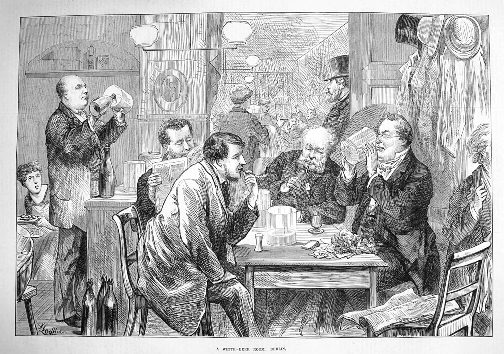
Englishmen drinking from humpens? most likely just the beer server!!
STILL ABOUT =
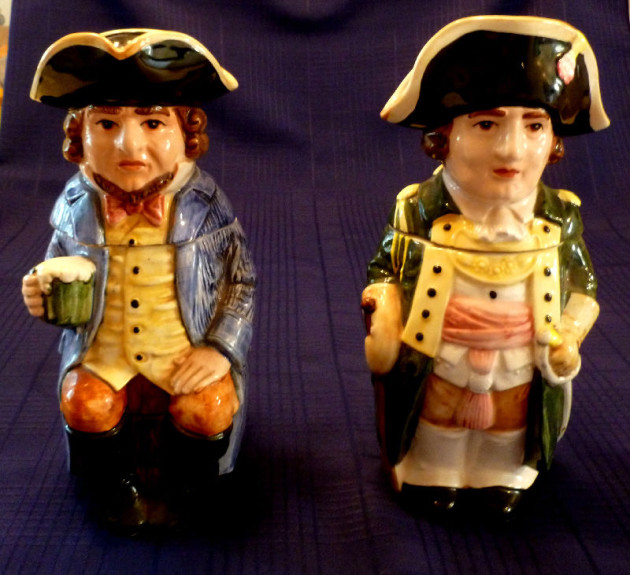
Hachiya Bros – Japanese new character steins = very bright colors. These are not Toby mugs!!
Hafnerware / Habnerware steins – Older pottery which had a lead glaze applied to the outside making the pieces very shiny in appearance. Very similar to majolica. Made in the 1500-1600’s time period. It predates the much *newer” German fayence [faience] which uses a tin glaze. Shown above: A 16th century, 7 liter jug, from Nurnberg.
See page: http://www.steveonsteins.com/german-majolia-beer-steins-and-a-few-from-the-munchner-werkstatten-fur-keramische-kunst-the-munich-workshop-for-pottery-artwork-new-7-24-12
Shown ▲: A Hafnerware lidless stein made in Austria, second half of the 16th century.
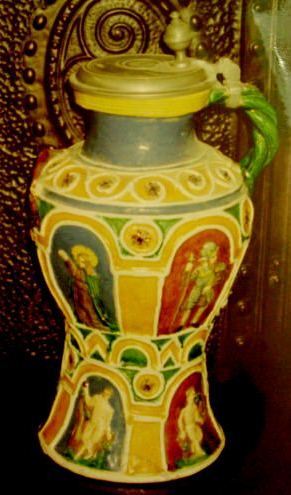
Shown ▲:-A “historismus” version of large stein in Habnerware. 18 inches tall – even this copy sold for over $2k in Germany in 2011.

Haida [the town is now called Nový Bor] glass – A Relatively famous (glashutte in Bohemia, at least very collectable products ) Above▲: A typical souvenir pokal; C.1930. Lots of this style [mostly ruby stained] were imported and sold here in the states.
Hairline — A closed break in the stein’s surface that sometimes shows as a thin black line in ceramic materials; contrast with “Crack” = LARGER. I am at a loss when I try to explain the differences by words alone.; so here are two examples that hopefully will show the difference:
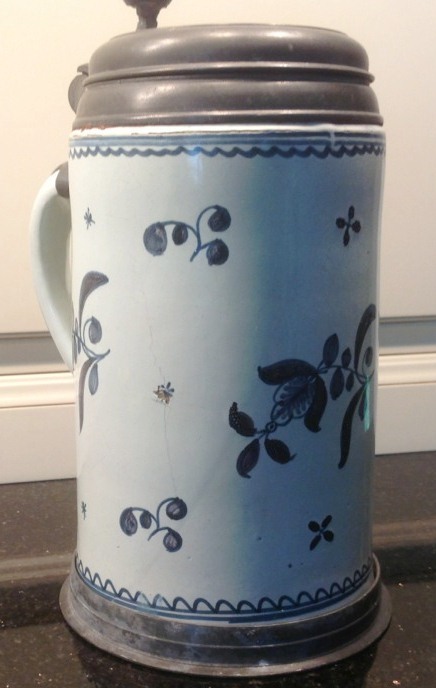
This stein’s “Hairline” is barely visible but runs from one design of the four berry and stem, just left of center, to the one below closer to the pewter base rim. A German Faience stein Ca. 1790’s.
.
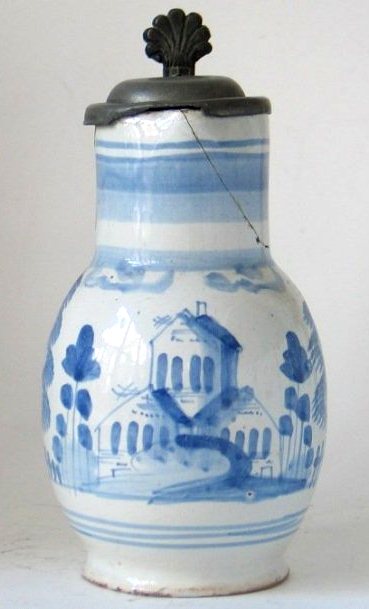
Crack = much larger and darker. Also on a Faience beer stein, this with an architectural design. Ansbach. Ca. 1750. [photo eBay’s “Stein-man.”)
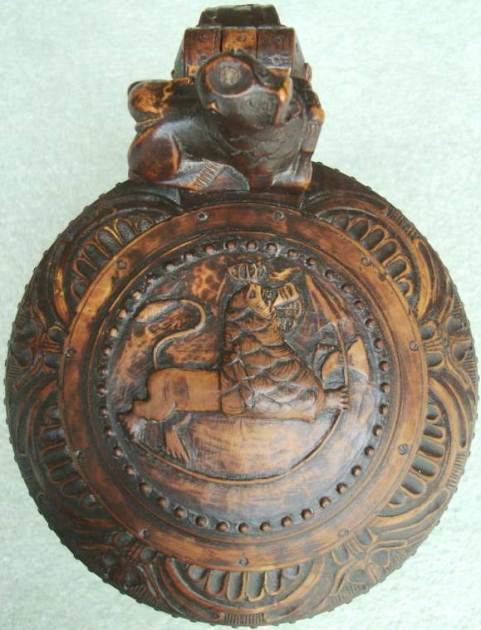
Halberd / Halbert- A hand weapon consisting of a long pole fitted with a metal head; the head consists of a blade similar to an axe and usually a spike or hook. A stylized halberd is seen ofter being held by a lion on wooden steins made in Norway for the Baltic trade. Shown ▲: The lid of a dated in the 1740’s Norwegian wooden tankard with its lion holding a curved Halberd.
For more on this type of wooden stein, See: http://www.steveonsteins.com/wooden-steins
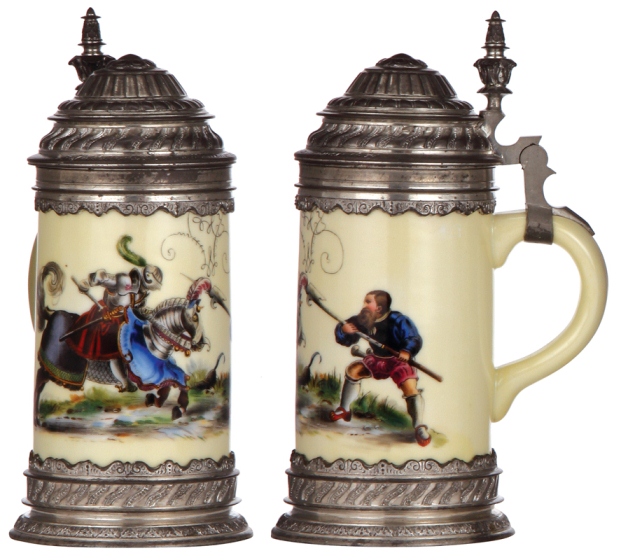
Shown ▲ : An interesting scene of a mounted knight against a footman with a Halberd! Porcelain stein, .5L, transfer & enameled, knight on horse, pewter lid & base, Unknown maker. Ca, 1875, perhaps even earlier = closed hung. [tsaco]
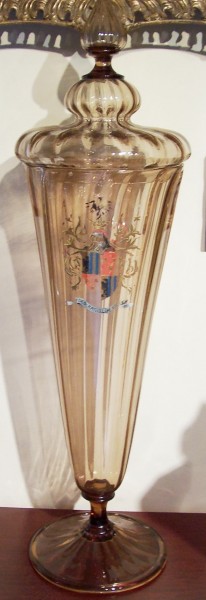 “
“
Hall in Tyrol” – Glass firm in the city of Hall, Austria which was started in the16th century. Very famous area for making “Façon De Venice” (“In the style of Venice”) glass. Shown ▲: A 21 inch tall, very light in weight, glass pokal with a cold painted Italian family’s Coat of Arms. Most likely made in “Hall -in-Tyrol”, which would have been fairly close by to Italy. Circa 1580. [FWTD] Photo shown in relative size of the piece.
Hallmark – A famous USA greetings card firm.
Oh, and also combinations of the following: the quality mark, makers mark, city mark, and date mark, stamped on English, Continental Scandinavian, and Russian silver items. Above▲: An English lidless tankard as they call them or a Cann. 1700’s.
For pewter items these marks are called “touch marks.”
Hallmarks on (German made) silver beer steins and beakers – If you are thinking of buying or researching a drinking vessel that appears to be of antique silver and made in Germany (based on style or looks) I think there is about a 75% chance that it was made as a copy of the older piece by one of the many silversmiths of Hanau Germany. The absolutely best reference to these marks and their makers can be found at:
Hanau Germany. http://www.925-1000.com/Fgerman_hanau_marks_01.html
and
http://www.925-1000.com/Fgerman_hanau.html
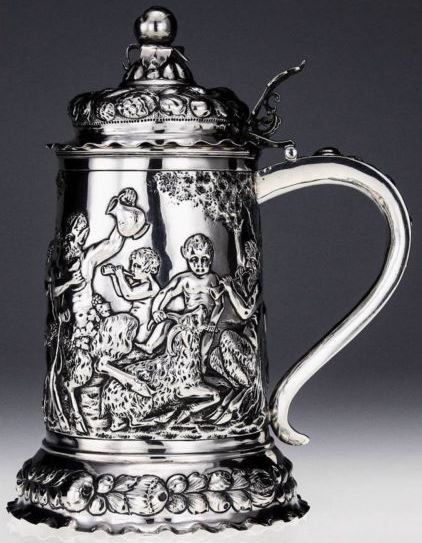
Stein above ▲ is made by the stamped silver process and not hand repossed and chased. It is one of a cheaper series of steins produced by one of the Hanau silver smiths. the series shows about five different scenes! (The most popular is of General Tilley riding his horse. As I run across them I will add then to this page. They have been priced on eBay from $2000 to $14,000,00 which is absolutely ridiculous for a stamped silver piece. It didn’t sell!
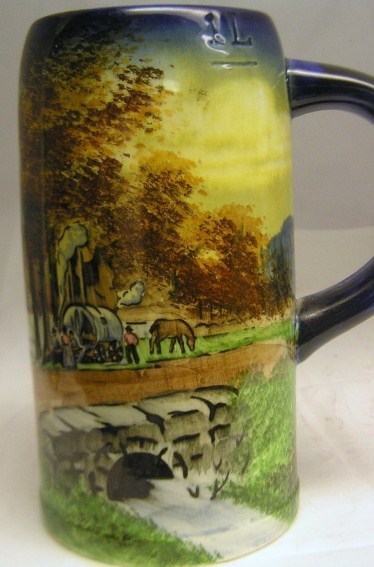
Halsey Fifth – Actually a German pottery firm with an English name. Shown ▲: One liter hand painted beer mug. See: http://www.steinmarks.co.uk/pages/pv.asp?p=stein1
HAMBURG CITY ARMS OF GET OTHERS [POKALS ] FOR COMP ENTRIES TSACO
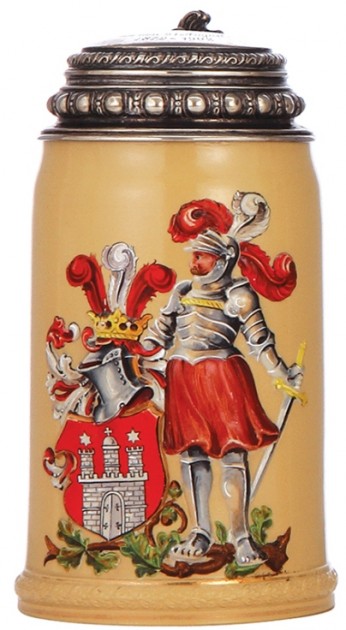
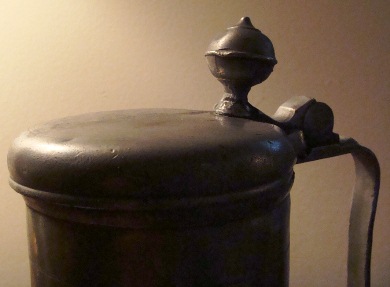
(Hamburger ) “Bun” lid – Pretty self explanatory. These are mostly found on large pewter steins made in the Baltic Sea area of northern Germany from about 1670 to 1800. Shown ▲: A “Bun” lid from a stein made in ‘Friesland’ (North Holland) Ca. 1680. [FWTD]
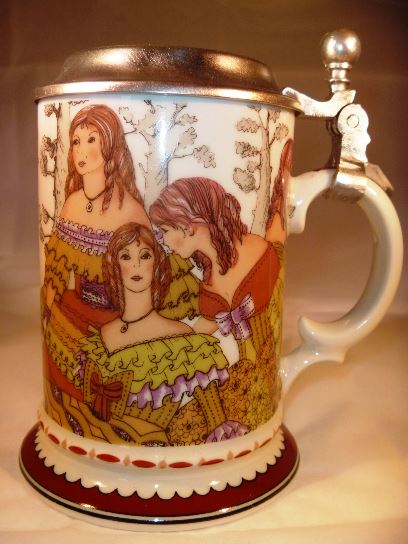
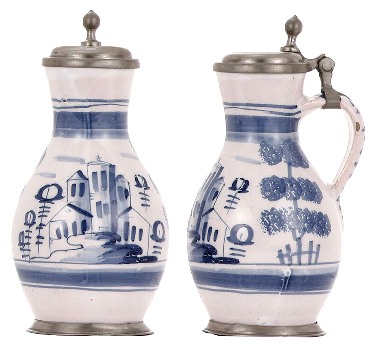
Hanau Fayence – 1661-1806 – City or town of major fayence stein production. For more info, see: http://www.thepatriotexchange.com/pss/hisfai.htm
Shown ▲: Typical fantasy building design on late Fayence 1700’s pieces from Hanau. [TSACO]
Hanau Silver — Also famous later for production of ” Historismus” silver vessels. See reference just above under “Hall Marks” ▲ ▲
Handarbeit – “Hand made’ in German. Unless you take this to be “Individually made” ,a mostly useless term. It defines nothing as most steins were done by hand. then production line assembled, painted and touched by many hands Used mostly on steins made after World War II.
Handle hump- A small protrusion on the inside of the handle to making the stein easier to hold. While most of the early “Regimentals”(Reservist’s) reproductions made in the 1950;s through the 1970’s have handle humps! Some regimental makers even got up to three humps, more like a custom pistol grip. But – the practice was started much earlier by some Westerwald potters.
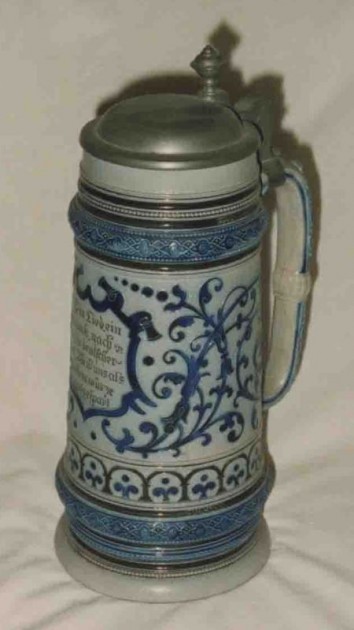
▲ Westerwald relief with a handle -hump
.
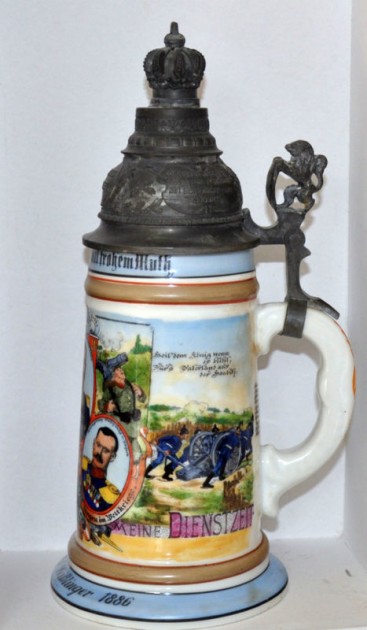
Early version “Regimental”reproduction stein from the 1970’s for more on tell tale signs, see:
http://www.steveonsteins.com/reservists-regimental-reproductions
.
Handle hole – See “Anchor Hole.
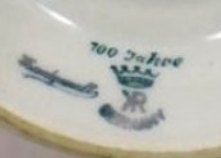
Handgemalt = “Hand painted” in German. – Also used on steins made after World War II, found on some pottery relief steins where the under glaze colors are applied by hand, an operation which bears little resemblance to what we think of as hand-painting. When seen on the bottom of a “reservist’s stein,” as shown above, it is an indicator the stein is a reproduction.
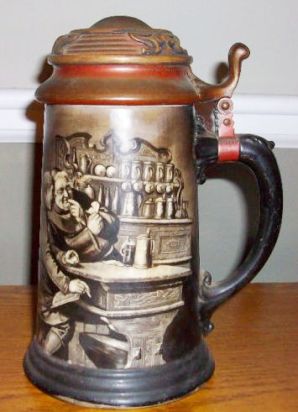
Hanging steins – Another misnomer – for what is shown above top right of body, see “Upside down steins.”
Shown: PUG of “Upside down” steins on a cupboard in a monastery. On a half liter Lenox (CAC) stein, American made porcelain, with a copper lid. Circa 1895.
See more hanging stein lids at: http://www.steveonsteins.com/lid-review-old-and-new-2
Hanke, Reinhold – A German pottery stein maker. Shown: Several example of the potter’s work – below left, an eight inch tall character owl by Hanke. Circa 1910. See: http://www.steinmarks.co.uk/pages/pv.asp?p=stein1
Other Hanke “types:”
.
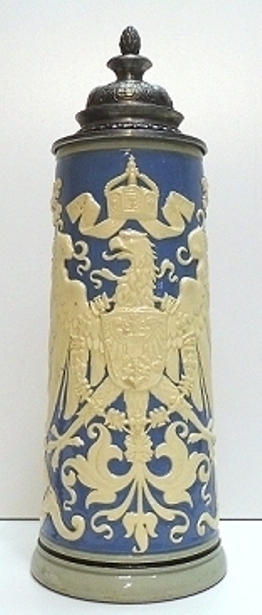
▲ One liter relief of the Imperial German Adler (Eagle). Hanke. Very well done .
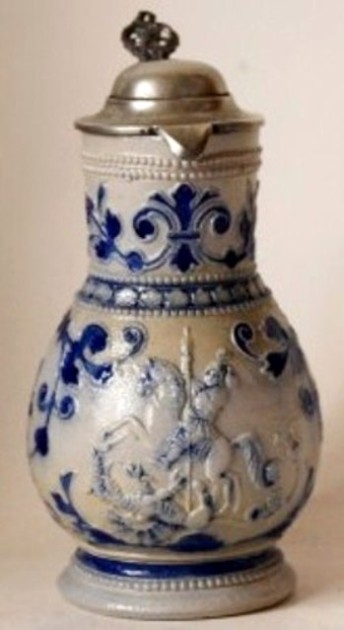
An always popular St. George and the dragon in relief stoneware by Hanke. This saint is always a best seller.
For many more St. George steins see:
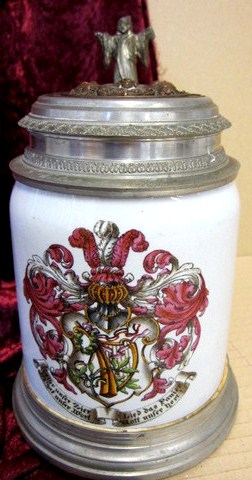
Hannes & Wieninger – Decorators of steins, Shown: A hand enameled Villeroy & Boch Mettlach stein for a musical society.
See: http://www.steinmarks.co.uk/pages/pv.asp?p=stein1
![Hannes & Wieninger Malerei auf Villeroy & Boch ! DECORATORS LIST IN CW'S -2 WHO DID THISD LID [Q]](http://www.steveonsteins.com/wp-content/uploads/2010/08/Hannes-Wieninger-Malerei-auf-Villeroy-Boch-DECORATORS-LIST-IN-CWS-2-WHO-DID-THISD-LID-Q.jpg)
A very nicely done “Bronzed” (but not bronze!) lid insert to go with the stein. Same society’s symbol.
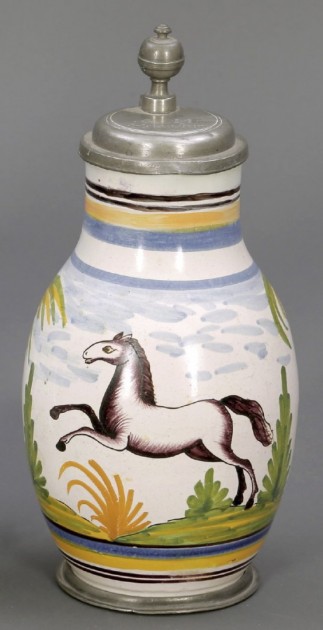
Hannoversch-Munden 1732-1854 – City or town of major fayence stein production. They are still making steins in the old manner. Shown ▲: A modern reproduction, of course being sold on eBay as an older version. [11-2012.]
For more info, see: http://www.thepatriotexchange.com/pss/hisfai.htm
Also see page: http://www.steveonsteins.com/no-4-guest-writers-articles-identifing-faience-steins-part-4-xxxxfayence-beer-steins-by-william-hamer
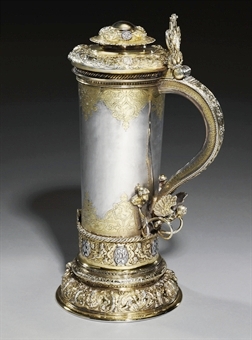
Hanse (or Baltic ) silver steins. – Tall thin van shaped silveer pieces distinquished by applied relief bands and a pomegranate finial on the end of an elaborate design of curved silver wires emanating from a ball finial placed about two thirds down the handle . These are very rare,!! and rate a 10 on the Smith Paratore scale.
So called very tall and fancy bodied silver steins, usually gilded on parts, from the 1500’s that were made in the Baltic states / cities that were part of the Hanseatic League. They have very unusual handle finials of small balls [pomegranates?] at the end of thick bent silver wires, as shown above ▲.
This one ▲ sold at Christies in France for €169,000 ($217,862.) Made by silver smith: HINRICH I LAMBRECHT, HAMBOURG. Dated 1599,
for an excellent close up shot on a video of one of these please see:
Harps (on beer steins) – See “Harpists on beer steins, what’s that about? –
on this web site: http://www.steveonsteins.com/harpists-on-beer-steins-whats-that-all-about
and as thumblifts: http://www.steveonsteins.com/unusual-pewter-thumblifts-prior-to1880
cr- HARVARD UNIVERSITY Beer Stein Tankard Glass Pewter Enamel SCHOOL SONG of all the usa colleges – universities Harvard seems to have ordered more beer steins back in the ‘golden era’
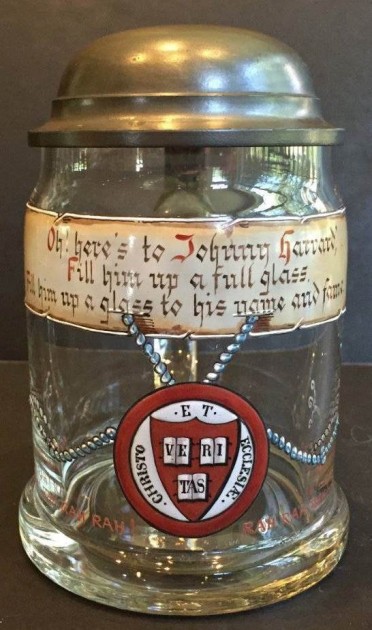
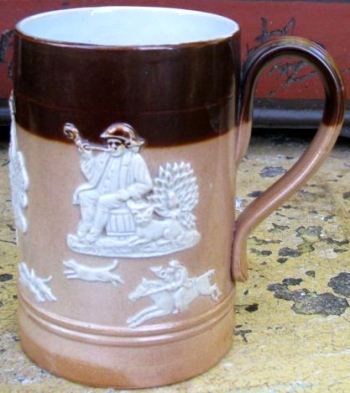
“Harvest Ale” Ware – Name of a type of stoneware made by Doulton Lambeth in England, in which the body colors on the mug are split in two = upper and lower. Usually dark brown on top and tan on the bottom, and sometimes with a silver rim as shown below. Applied reliefs in white showing gentry scenes are attached by slip.
So what exactly is “Harvest Ale?” I did not know either, so I looked it up. Here’s at least two versions from “Lee’s Harvest Ale” web site, thank you Lee’s !
Seasonal brews have been with us since the earliest midst of brewing time.Beers to mark a specific ceremony or event have their origins in our earliest form of communal living. Whether to celebrate the joys of a forthcoming nuptials, or to mark the more sombre affair of the annual Audit, in nearly every case a special beer was required to mark the occasion!
Some however are more specific, and have almost pagan roots, acknowledging the importance nature played in the annual cycle of our everyday existence – and ‘Harvest Ales’ are one such beer. As a style however it seems to have followed two distinct historical paths.
One interpretation of ‘Harvest Ale’ was for the the finished brews themselves to be brought to the farms by the Squire or Landlord during the harvest period as a gratuity for the workers to quench their thirsts! This tradition was still very much alive in the rural areas of Ireland in the 1950s and 60s with a story relayed to me by Mr. Maurice Morrison when harvesting malting barley in Midleton, Co. Cork. A small wooden barrel of stout (believed to be Guinness) was made available to the workers in the field – and went by the name of ‘Harvest Porter’ (being a lower strength version of the stout) – and was much appreciated by all concerned!
The other tradition did not refer so much to the consumption of the previous seasons wares, but a celebration of the new ‘Harvest’ itself, and more akin to our ancestral roots, and in more recent times the brewers of the American West Coast have adopted a variation of this theme with new season hops, often unkilned, providing the link with the new born Harvest.
In Britain however, whilst there are several brewers who produce variations of the style at the lower alcohol level, one beer in particular stands out as representing a tangible link with the past, by not just using new season hops, but malt also – Lees Harvest Ale.
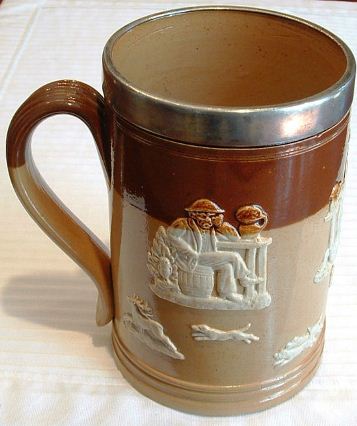
Hasse – Herr. Edmund Haase was responsible for the whole of the original character stein range (according to Schierholz records,) The Hops Lady is one of his. Info compliments of “Stein Marks.”
.
.
Hauber & Reuther, ( H-R)- A large volume beer stein maker / supplier. I am of the opinion that their best quality steins were almost as good as V & B Mettlach. Shown: [Top L] PUG, [Top R] Tapestry. [BL] Incised (“Etched”).
See:http://www.steinmarks.co.uk/pages/pv.asp?p=stein1
Hausmalers (Germ.) – House or studio painters.By the mid-1600’s German houses were often built to include artists’ studios. The artists who occupied them decorated mostly porcelain or faience wares, working as independent craftsmen in their own home studios. See article: http://www.collectorsweekly.com/articles/hausmaler-decoration-on-fayence-and-porcelain/
HB (“Hofbräuhaus”) – The Staatliches Hofbräuhaus in München (state court-brewery in Munich.) One of the most famous beer drinking halls in the world, located in Munich. Steins made for this establishment were from many companies, over many years, and most were not paid for at the cashier’s desk while going to a new home!
Shown: A stoneware 1/2 liter with an interesting design, with more than the usual “HB” in cobalt blue being on the front. Unknown maker and years. [tsaco]
The HB stein registry-– A new beer stein research site maintained by Mr. Jordan Vandenberg
“I have been conducting some research on HB steins to try better pinpoint the age of the steins and how they evolved. To help with my research as well as catalog for collectors the numbered HB steins, I have started an HB stein registry. Collectors who have numbered HB steins can submit pictures of the stein, a description, price paid (optional), as well as contact info and it will be entered in the registry (optional). I am also trying to track EBay for pictures of some of the numbered steins to add into the registry. This registry will be updated and sent out to those who have contributed to the registry each month. Some of the benefits of joining the registry are: HB stein collectors will get a chance to see what else is out there, correspond with others who collect, avenue to trade and by numbered HB steins, and to help uncover the history of the steins. Anyone willing to join is welcome. Please e-mail me at jordanvandenberg@hotmail.com. There is a picture of what I mean by it at my blog http://hbsteins.blogspot.com/ “
NOTE: I have included this site in the compendium as I think the research coming out of it will be interesting and useful for a lot of Brewery stein or Munich stein collectors. steveonsteins readers are urged to participate.

Yes I know, she’s drinking the wrong (but another major) kind of beer at the Oktoberfest and not HB, but do you think I care?
.
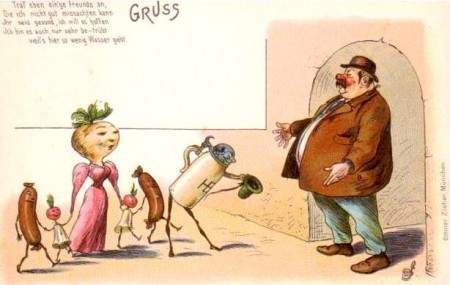
[END – SP104 – 40 – R5]
 “If the number 2 pencil is the most popular, why i s it still number 2?
“If the number 2 pencil is the most popular, why i s it still number 2?

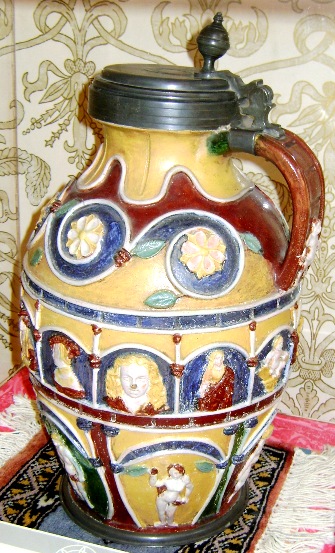
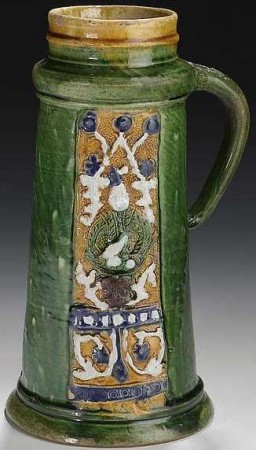
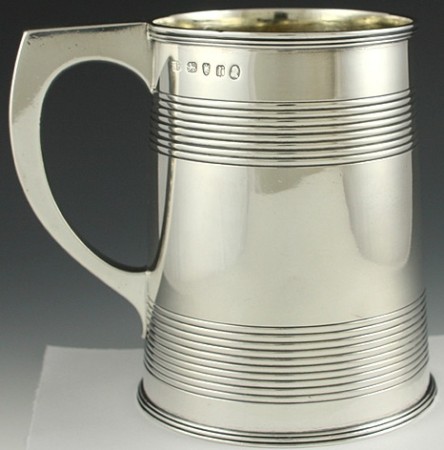
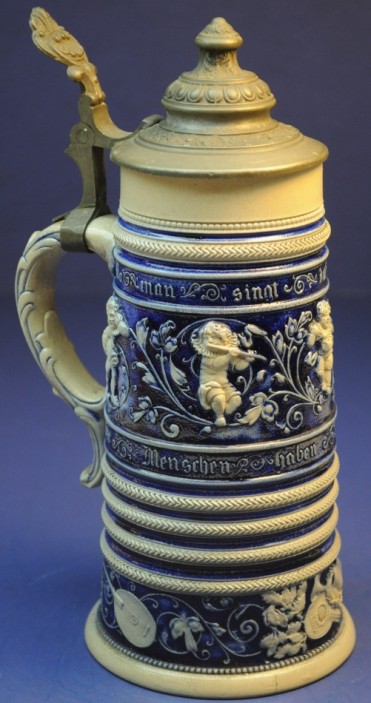
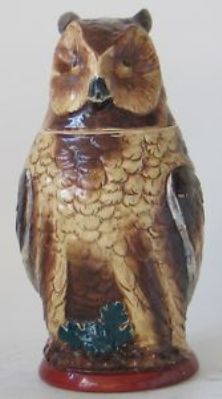
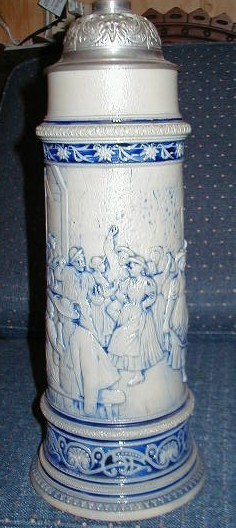
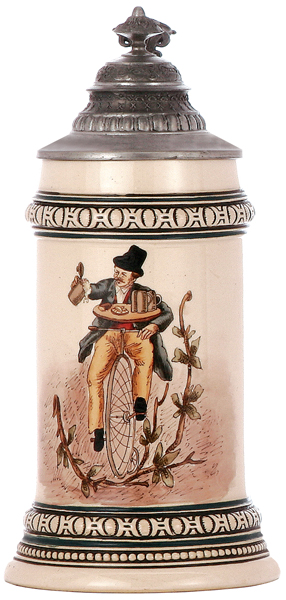
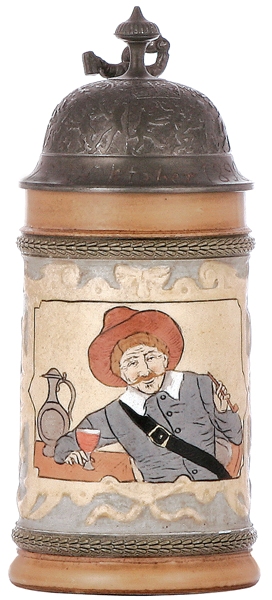
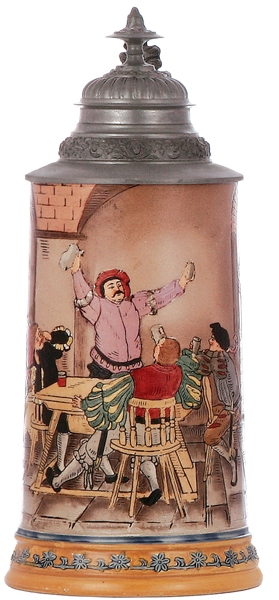
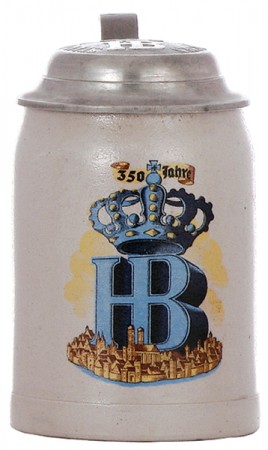
Leave a Reply